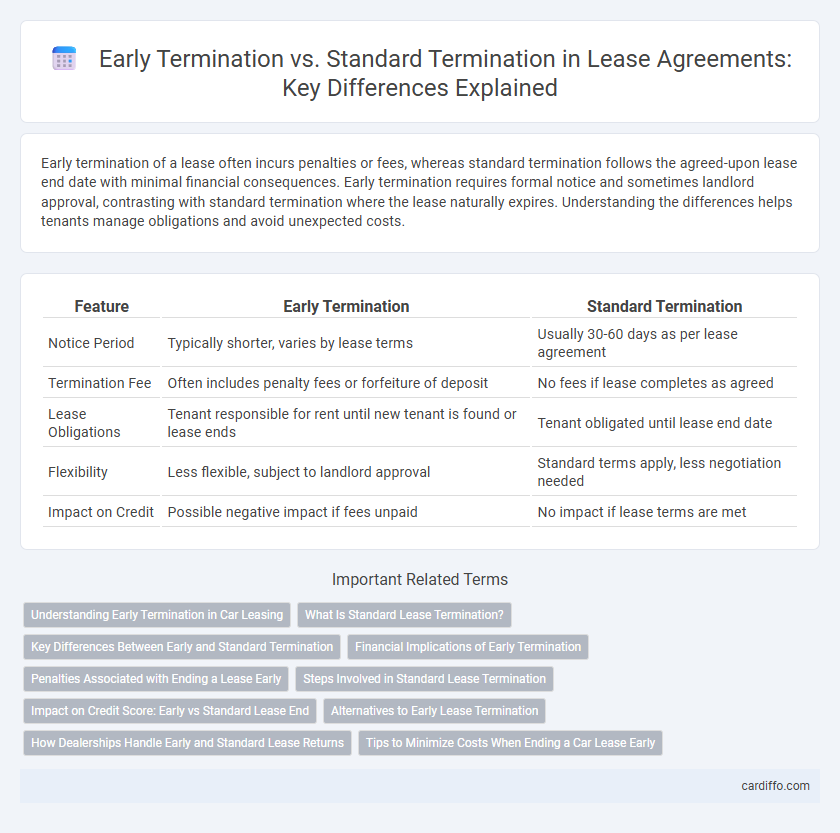Early termination of a lease often incurs penalties or fees, whereas standard termination follows the agreed-upon lease end date with minimal financial consequences. Early termination requires formal notice and sometimes landlord approval, contrasting with standard termination where the lease naturally expires. Understanding the differences helps tenants manage obligations and avoid unexpected costs.
Table of Comparison
| Feature | Early Termination | Standard Termination |
|---|---|---|
| Notice Period | Typically shorter, varies by lease terms | Usually 30-60 days as per lease agreement |
| Termination Fee | Often includes penalty fees or forfeiture of deposit | No fees if lease completes as agreed |
| Lease Obligations | Tenant responsible for rent until new tenant is found or lease ends | Tenant obligated until lease end date |
| Flexibility | Less flexible, subject to landlord approval | Standard terms apply, less negotiation needed |
| Impact on Credit | Possible negative impact if fees unpaid | No impact if lease terms are met |
Understanding Early Termination in Car Leasing
Early termination in car leasing allows lessees to end their contract before the agreed-upon term, often incurring penalty fees or paying remaining lease obligations. Understanding early termination clauses requires reviewing the lease agreement for specific conditions, such as mileage limits, wear and tear standards, and termination fees. Comparing early termination costs with standard lease-end procedures helps lessees make informed decisions to avoid excessive financial penalties.
What Is Standard Lease Termination?
Standard lease termination occurs when a tenant or landlord ends the lease agreement at the predetermined expiration date specified in the contract, following all terms and conditions without penalties. This process typically involves providing written notice within the timeframe outlined in the lease, allowing both parties to prepare for vacating or re-leasing the property. Standard termination ensures legal compliance and avoids financial liabilities compared to early termination, which usually incurs fees or forfeiture of deposits.
Key Differences Between Early and Standard Termination
Early termination of a lease involves ending the contract before the agreed-upon expiration date, often incurring penalties or fees, whereas standard termination occurs at the predetermined end of the lease period without additional charges. Early termination typically requires landlord approval or specific lease clauses allowing for such action, while standard termination follows the lease's natural conclusion with proper notice given. Financial implications and legal obligations differ significantly, making early termination a more complex and costly process compared to standard termination.
Financial Implications of Early Termination
Early termination of a lease often results in significant financial penalties, including forfeiture of the security deposit and liability for unpaid rent until a new tenant is found. Standard termination typically aligns with the lease's end date, minimizing unexpected costs and allowing for proper notice periods to avoid additional charges. Understanding these financial implications is crucial for tenants to assess potential costs and budget accordingly when considering early lease termination.
Penalties Associated with Ending a Lease Early
Terminating a lease early often incurs significant penalties, including paying a predetermined early termination fee or forfeiting the security deposit. Standard termination aligns with the lease's agreed-upon end date, typically avoiding extra charges if proper notice is given per the contract terms. Lease agreements specify these financial consequences to ensure tenants understand the cost implications of ending the lease prematurely versus fulfilling the full term.
Steps Involved in Standard Lease Termination
Standard lease termination requires the tenant to provide a written notice to the landlord specifying the intention to vacate, typically 30 to 60 days before the lease end date according to the lease agreement terms. The tenant must ensure the property is returned in good condition, accounting for any normal wear and tear, and arrange for a final inspection with the landlord. Security deposit returns are processed after this inspection, contingent on the property's condition and any outstanding payments or damages.
Impact on Credit Score: Early vs Standard Lease End
Early termination of a lease can significantly impact your credit score due to potential reporting of unpaid fees or penalties by the lessor, whereas standard lease termination typically reflects positively as it follows agreed-upon terms. Credit bureaus receive timely updates when leases end as scheduled, showing responsible financial behavior, while early termination may trigger collections if outstanding balances remain. Maintaining standard lease completion helps preserve a stable credit history, minimizing risks of downgraded credit ratings.
Alternatives to Early Lease Termination
Alternatives to early lease termination include lease transfers, subletting, and negotiating a lease buyout with the landlord. Lease transfers allow tenants to assign their remaining lease term to a new tenant, avoiding penalties commonly associated with early termination. Subletting provides temporary occupancy by another party while maintaining lease obligations, whereas lease buyouts involve a one-time payment to end the lease agreement before its standard expiry.
How Dealerships Handle Early and Standard Lease Returns
Dealerships handle early lease terminations by often imposing early termination fees, which cover the remaining depreciation and lease balance, whereas standard lease returns typically incur minimal or no penalty if the lease term is completed as scheduled. Early returns require dealerships to assess vehicle condition and mileage to determine any excess wear or mileage charges, while standard returns focus primarily on inspection for compliance with lease-end conditions. Many dealerships offer lease-end buyout options or lease extensions to mitigate early termination costs, providing flexibility for customers facing unexpected changes.
Tips to Minimize Costs When Ending a Car Lease Early
When ending a car lease early, review the lease agreement for specific early termination fees and potential penalties to avoid unexpected costs. Consider transferring the lease to another qualified driver or using a lease buyout option to reduce financial burden. Maintaining the vehicle in excellent condition and keeping thorough records of all payments can also help negotiate lower fees or avoid additional charges.
Early Termination vs Standard Termination Infographic

 cardiffo.com
cardiffo.com